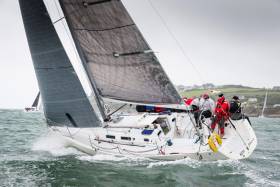Displaying items by tag: John Maybury
John Maybury is “Sailor of the Month (Cruiser-Racer)” for July
The complexities of Volvo Cork Week 2022 may have obscured some of the important National Championships taking place within it and its many classes. But aboard the more serious boats, the “hidden target” was the ICRA Nationals 2022, and the focus on this sharpened as the Week progressed until, in the end, the popular winner was J/109 stalwart John Maybury (Royal Irish YC) with his efficiently-campaigned Joker II, a boat which is no stranger to the podium as Afloat reports here
John Maybury's Joker 2 crew from the Royal Irish Yacht Club in Dun Laoghaire Harbour are racing on a chartered J122 and currently lying second in the Les Voiles de St Barths regatta.
It has been a week of big breeze and big seas but the Joker 2 crew have comfortably stepped up from their J109 to a J122 and are racing in CSA4 division.
A Mark Mills designed Summit 40 is currently leading the fleet and seems to have pace on the others boats. See regatta results here
After a well-deserved day off, the crews of the 11th edition of the Voiles de St. Barth Richard Mille got back to work on Friday but it was not without drama.
Cape 31 dismasted
Another Royal Irish member, Niall Dowling and his Cape 31 Arabella crew, who are the overall leaders of division CSA2, were dismasted during the first start of the day following a collision with another competitor according to local reports here
John Maybury is June 'Sailor of the Month' (Inshore)
Although the Irish Cruiser Racing Association caters for boats with offshore potential, the annual ICRA Nationals are fought with all the intensity of a major inshore series, and the pressure of several races a day keeps up the heat.
The ICRA Nats 2017 at the Royal Cork YC from June 9th to 11th were intense and then some, as the weather pattern was distinctly unfavourable. For participants, it was a matter of keeping one’s cool and dealing with the challenge in hand. It was only after his J/109 Joker 2 had won Division I that John Maybury (Royal Irish YC) allowed himself to realise he had done it three times in a row. Joker 2 has now been champion in varied conditions in Kinsale in 2015, in mostly light airs at Howth in 2016, and in heavy weather at Crosshaven in 2017. An unrivalled record, and a clearcut “Sailor of the Month”.























